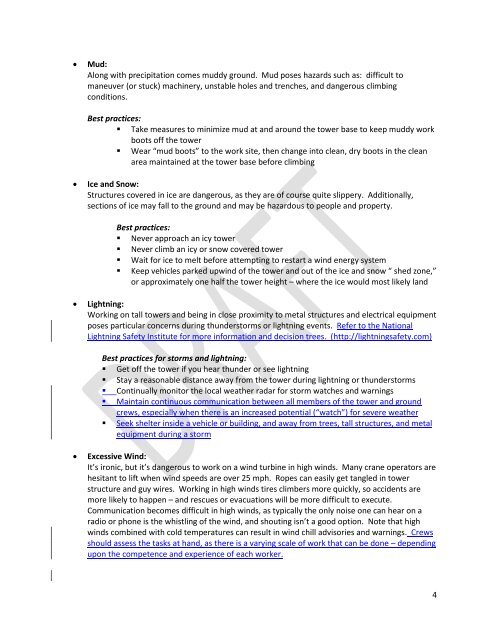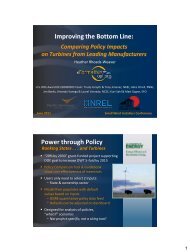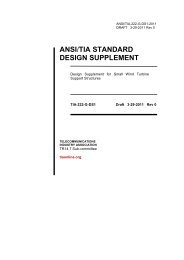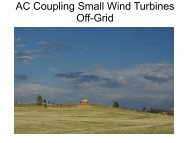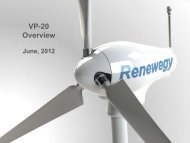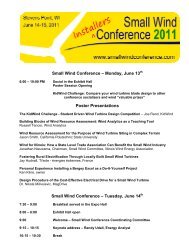Best Practices in Small Wind: Tower Climbing Safety
Best Practices in Small Wind: Tower Climbing Safety
Best Practices in Small Wind: Tower Climbing Safety
Create successful ePaper yourself
Turn your PDF publications into a flip-book with our unique Google optimized e-Paper software.
� Mud:<br />
Along with precipitation comes muddy ground. Mud poses hazards such as: difficult to<br />
maneuver (or stuck) mach<strong>in</strong>ery, unstable holes and trenches, and dangerous climb<strong>in</strong>g<br />
conditions.<br />
<strong>Best</strong> practices:<br />
� Take measures to m<strong>in</strong>imize mud at and around the tower base to keep muddy work<br />
boots off the tower<br />
� Wear “mud boots” to the work site, then change <strong>in</strong>to clean, dry boots <strong>in</strong> the clean<br />
area ma<strong>in</strong>ta<strong>in</strong>ed at the tower base before climb<strong>in</strong>g<br />
� Ice and Snow:<br />
Structures covered <strong>in</strong> ice are dangerous, as they are of course quite slippery. Additionally,<br />
sections of ice may fall to the ground and may be hazardous to people and property.<br />
<strong>Best</strong> practices:<br />
� Never approach an icy tower<br />
� Never climb an icy or snow covered tower<br />
� Wait for ice to melt before attempt<strong>in</strong>g to restart a w<strong>in</strong>d energy system<br />
� Keep vehicles parked upw<strong>in</strong>d of the tower and out of the ice and snow “ shed zone,”<br />
or approximately one half the tower height – where the ice would most likely land<br />
� Lightn<strong>in</strong>g:<br />
Work<strong>in</strong>g on tall towers and be<strong>in</strong>g <strong>in</strong> close proximity to metal structures and electrical equipment<br />
poses particular concerns dur<strong>in</strong>g thunderstorms or lightn<strong>in</strong>g events. Refer to the National<br />
Lightn<strong>in</strong>g <strong>Safety</strong> Institute for more <strong>in</strong>formation and decision trees. (http://lightn<strong>in</strong>gsafety.com)<br />
<strong>Best</strong> practices for storms and lightn<strong>in</strong>g:<br />
� Get off the tower if you hear thunder or see lightn<strong>in</strong>g<br />
� Stay a reasonable distance away from the tower dur<strong>in</strong>g lightn<strong>in</strong>g or thunderstorms<br />
� Cont<strong>in</strong>ually monitor the local weather radar for storm watches and warn<strong>in</strong>gs<br />
� Ma<strong>in</strong>ta<strong>in</strong> cont<strong>in</strong>uous communication between all members of the tower and ground<br />
crews, especially when there is an <strong>in</strong>creased potential (“watch”) for severe weather<br />
� Seek shelter <strong>in</strong>side a vehicle or build<strong>in</strong>g, and away from trees, tall structures, and metal<br />
equipment dur<strong>in</strong>g a storm<br />
� Excessive W<strong>in</strong>d:<br />
It’s ironic, but it’s dangerous to work on a w<strong>in</strong>d turb<strong>in</strong>e <strong>in</strong> high w<strong>in</strong>ds. Many crane operators are<br />
hesitant to lift when w<strong>in</strong>d speeds are over 25 mph. Ropes can easily get tangled <strong>in</strong> tower<br />
structure and guy wires. Work<strong>in</strong>g <strong>in</strong> high w<strong>in</strong>ds tires climbers more quickly, so accidents are<br />
more likely to happen – and rescues or evacuations will be more difficult to execute.<br />
Communication becomes difficult <strong>in</strong> high w<strong>in</strong>ds, as typically the only noise one can hear on a<br />
radio or phone is the whistl<strong>in</strong>g of the w<strong>in</strong>d, and shout<strong>in</strong>g isn’t a good option. Note that high<br />
w<strong>in</strong>ds comb<strong>in</strong>ed with cold temperatures can result <strong>in</strong> w<strong>in</strong>d chill advisories and warn<strong>in</strong>gs. Crews<br />
should assess the tasks at hand, as there is a vary<strong>in</strong>g scale of work that can be done – depend<strong>in</strong>g<br />
upon the competence and experience of each worker.<br />
4


